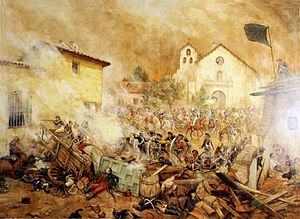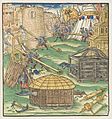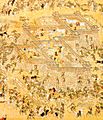Siege facts for kids
A siege is like a long, drawn-out attack on a city or a strong fort. It happens when an army surrounds a place to cut off its supplies and stop anyone from getting in or out. The goal is to make the people inside give up, either by starving them out or by breaking down their defenses. The word "siege" comes from a Latin word meaning "to sit," because the attacking army "sits" outside the target for a long time.
This type of fighting, called siege warfare, is a slow and steady conflict. One side holds a very strong defensive spot. Because the armies are so close for a long time, they sometimes talk to each other to try and find a peaceful solution. The skill of planning and carrying out sieges, or even defending against them, is also called siegecraft.
Contents
Why Sieges Happen
A siege begins when an attacking army finds a city or fort that is too strong to capture quickly. If the people inside refuse to surrender, the attackers will surround the place. This act of surrounding is called "investment." It stops food, water, and new soldiers from reaching the defenders. It also prevents anyone from escaping.
How Attackers Break Defenses
Besides cutting off supplies, attackers try to break down the walls and defenses. They use special tools and weapons like:
- Siege engines: Big machines designed to attack forts.
- Artillery: Powerful cannons that fire projectiles.
- Mining: Digging tunnels under walls to make them collapse.
- Tricks: Sometimes, they use clever plans or even get help from someone inside to get past the defenses.
How Sieges End
If military attacks don't work, sieges can often end because people run out of food, water, or get sick. This can happen to either the attackers or the defenders. These types of sieges can last for many months or even years, depending on how much food and water the fort has stored.
Surrounding the Enemy
Sometimes, the attacking army builds a ring of earth walls and trenches around the besieged place. This is called circumvallation. It helps to keep the defenders trapped inside. But because this takes a long time, another enemy army might come to help the besieged city. To protect themselves from this outside help, the attackers might build another ring of forts facing outwards. This second ring is called contravallation.
Sieges Through History
Sieges have been a big part of warfare for thousands of years.
Ancient Times
Ancient cities in the Middle East often had very strong city walls, showing they were ready for sieges. In ancient China, during the Warring States era, there are records and evidence of long sieges and special machines used to attack city walls. The ancient Greeks and Romans also used many different siege machines.
Medieval and Early Modern Eras
During the Middle Ages, military campaigns often involved a series of sieges. Armies would move from one castle or city to the next, trying to capture them. In the Renaissance and early modern period, sieges were still very important in European wars. Even famous artists like Leonardo da Vinci were known for designing strong forts!
Modern Warfare
By the time of Napoleon, cannons became much more powerful. This made old-style forts less useful. In the 20th century, the importance of traditional sieges went down even more. With faster, more mobile armies, a single strong fort wasn't as important as it used to be.
While classic sieges are not as common today, they still happen. Modern sieges are often smaller, like when police surround a building where criminals or hostage-takers are hiding.
Images for kids
-
Depiction of the siege of Lisbon, 1147
-
The Egyptian siege of Dapur in the 13th century BC, from Ramesseum, Thebes
-
Medieval trebuchets could sling about two projectiles per hour at enemy positions.
-
Cahir Castle in Ireland was besieged and captured three times: in 1599 by the Earl of Essex, in 1647 by Lord Inchiquin, and in 1650 by Oliver Cromwell.
-
Late 16th-century illustration of cannon with gabions
-
The siege of Candia, regarded as one of the longest sieges in history (1648–1669)
-
Vauban's star-shaped fortified city of Neuf-Brisach
-
The Battle of Vienna took place in 1683 after Vienna had been besieged by the Ottoman Empire for two months.
-
Storming of Redoubt#10 during the siege of Yorktown
-
British infantry attempt to scale the walls of Badajoz, Peninsular War, 1812
-
Map showing Axis encirclement during the siege of Leningrad (1942–1943)
-
Map of destroyed infrastructure following the Siege of Marawi, 2017
See also
 In Spanish: Asedio para niños
In Spanish: Asedio para niños






















